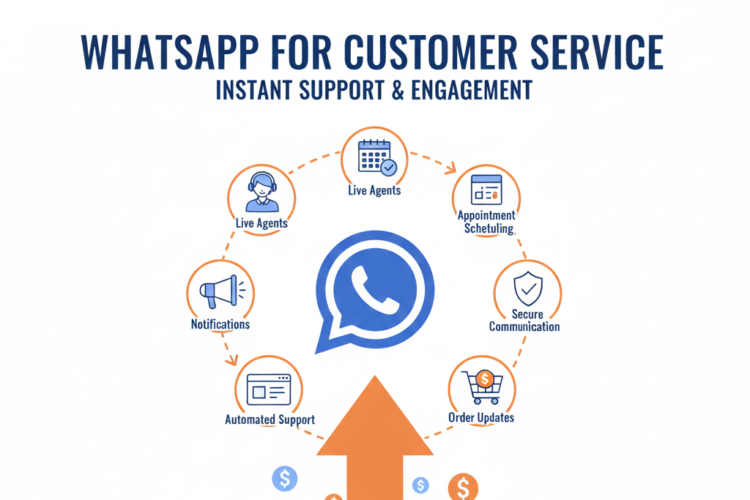
How to Handle Customer Complaints via WhatsApp
WhatsApp has emerged as a powerful tool for customer service. With over 2 billion users globally, it offers a fast, personal, and convenient channel for brands to communicate directly with customers. But with convenience comes expectations—especially when it comes to handling complaints.
In this guide, you’ll learn how to respond to complaints professionally, empathetically, and efficiently to protect your brand reputation and retain trust.
Why WhatsApp for Customer Complaints?
-
Real-time communication: Customers expect quick responses.
-
Personalized experience: Messages feel 1-on-1 and private.
-
Convenience: Customers can complain on their terms, in their time.
-
Traceability: Every chat is logged and easy to revisit.
-
Automation potential: Quick replies and chatbots can improve speed.
1. Set Expectations Early
✅ Use Automated Welcome Messages
When a customer reaches out, greet them with an automatic message like:
“Hi! 👋 Thanks for contacting [Brand Name]. We’ve received your message and will get back to you within [X] minutes. If this is a complaint, we’ll prioritize it. 💬”
Benefits:
-
Acknowledges the message
-
Reduces frustration during wait times
-
Sets tone and response time expectation
2. Respond Quickly—But Thoughtfully
-
First response within 5–15 minutes is ideal.
-
Even if you don’t have an answer, let them know you’re working on it.
Example:
“Thanks for reaching out, [Name]. I’m really sorry to hear about this. Let me check with the team and get back to you shortly.”
3. Stay Empathetic and Polite (Always)
Use empathy-focused language:
-
“I understand how frustrating this must be…”
-
“I’m really sorry you’ve experienced this…”
-
“Thank you for bringing this to our attention…”
Avoid blame or defensiveness. Even if the issue isn’t your fault, own the resolution process.
4. Ask Clarifying Questions Gently
Sometimes complaints are vague. Ask follow-up questions respectfully.
Example:
“Just to understand the issue better, can you please share the order number or a photo of the item you received?”
Keep your tone neutral and helpful—not interrogative.
5. Offer Solutions, Not Excuses
Once the issue is clear:
-
Explain what went wrong (briefly)
-
Present a clear solution
-
Give options if available
Example:
“It looks like your parcel was delayed due to a courier issue. We can either resend your order with express shipping or issue a full refund. Which would you prefer?”
6. Personalize the Experience
Use their name. Mention specifics from the complaint. Avoid copy-paste responses.
Instead of:
“We apologize for the inconvenience.”
Say:
“Hi Priya, I’m really sorry your lipstick arrived damaged. We know how disappointing that is, and we want to make it right.”
7. Use Rich Media for Better Support
WhatsApp allows:
-
Images (to confirm product issues)
-
Voice notes (to personalize responses)
-
PDFs (manuals, policies, instructions)
Example:
Send a return form PDF or a video guide on fixing a common issue.
8. Escalate When Necessary
Set internal SOPs:
-
Which complaints can be handled by frontline agents?
-
Which ones need to be escalated to a supervisor?
Use lines like:
“I want to ensure you get the best help possible. Let me escalate this to our specialist team—they’ll reach out to you shortly.”
9. Close the Loop Gracefully
After resolving the issue:
-
Confirm the customer is satisfied
-
Say thank you
-
Invite further feedback
Example:
“I’m glad we could get that sorted. Thanks for your patience, and we’re really sorry again. If there’s anything else we can help with, feel free to message us anytime. 😊”
10. Track & Analyze Complaint Patterns
Use WhatsApp Business tools to:
-
Tag chats by issue type (e.g., “Late Delivery”, “Product Defect”)
-
Measure response and resolution times
-
Identify frequently raised concerns
This data can help improve products, shipping, or customer service processes.
Bonus Tips
💬 Use WhatsApp Quick Replies
Save time on frequent complaint responses with pre-set replies.
🤖 Integrate Chatbots for Initial Triage
Use bots to gather complaint info before passing to a human.
📆 Be Available (or Communicate When You’re Not)
If you’re unavailable outside working hours, let customers know with an away message and tell them when you’ll respond.
Conclusion
WhatsApp is more than a chat app—it’s a critical frontline for brand reputation and customer trust. When handled well, a complaint isn’t just a problem—it’s an opportunity to build loyalty.
Remember:
-
Be fast
-
Be human
-
Be accountable
-
Be solution-oriented
Done right, even a frustrated customer can become your brand’s biggest advocate.
Author



